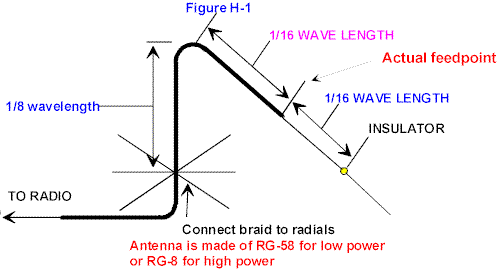ack in October 1989, the entire paper magazine issue of antenneX
was dedicated to a new antenna concept that engineer/inventor, Ted Hart, W5QJR had come up
with in the course of trying to develop a good feed method for his tower on 160 meters. In
the process he came up with the antenna that is depicted in Figure H-1. This rather odd
looking antenna is a very interesting antenna in that it worked when it was taped to the
leg of his existing tower. If it was tuned up there or if it was strung up with an
insulating support, it worked just as well. But, an existing tower isn't essential—a
tree or similar support will do fine. Here's how Ted's article introduction describes the
concept:
"A short wire can be added to an existing tower (or hung from a tree) to form an
excellent low band antenna. This antenna combines the features of a
horizontal and a vertical antenna to provide constant signal level to all stations from near-in
to more than 1,000 miles. It is the optimum antenna for rag chewing and net
operation on 40, 80 and 160 meters. It is also an excellent DX antenna."
RUNS LOW POWER
So I put one up for 75 meters that was only 32 ft. (9.75 meters) tall. To say it worked is
mild. I was only running about 15 watts out and got some reports that were far better than
I would have imagined. No one believed I was running so little power. A report of 20 over
9 from Los Angles was the first one I got—then a 30 over from Atlanta, followed by a
25 over from Cuba was enough to convince me that this antenna worked. No only did I get
these good reports, I could hear Ted, who lived in Melbourne, Florida, which is about
1,100 miles due east from me across the Gulf of Mexico. He was working into Europe and
making contacts in just about every country east of Moscow. Ted had only a TS-440 on the
air, running 100 watts and he was getting good reports. Also, I could hear the stations he
was talking to, but could not break into the pileups due to my low power. Moreover, I had
a rather large amount of power lines, telephone cables and other utility lines surrounding
my antenna. These lines were to the East of my antenna and also very close to the antenna.
I am sure that these multiple conductors had a definite effect on my signal in that
direction.
SIMPLE CONSTRUCTION
The interesting thing about this is that the antenna was hung from a 35 ft. (10.67 meters)
pole held up by a 20 foot (6.10 meter) redwood pole. There was no problem tuning up the
antenna, and it worked as long as I had it up. The construction of the antenna is simple
and well described in the October, 1989 issue, which is in the Library archives. This
antenna is well qualified to be a disguised antenna, since it is so short for the lower
frequencies—32 ft.(9.75 meters) for 75 meters, 16 ft (4.87 meters) for 40 meters, and
the size goes down from there. An interesting feature is that the folded-over portion of
the antenna can be straightened out and extended straight up after going up in frequency
past 20 meters. The folded part of the antenna adds a horizontal component to the radiated
signal, which enables you to make more reliable contacts in closer than a pure vertical
antenna would. This is due to the horizontal and vertical mixture of radiated energy
giving higher angle radiation to the signal, yet enough vertical radiation for DX work.
REALLY DISGUISED
This is a very unusual antenna, indeed. It can be put up easily and tuning is not that
difficult either. It does work and work well. I have no explanations other than it is
another of these antennas that came into being by accident. A very pleasant accident as
well, I might add. One thing that is also interesting is that it does not look like an
antenna, which adds to the disguisability of the antenna.
Another experimenter who put one of these antennas up was G6RJ, Rob. He had very good
results working into the Far East with excellent reports via long path on 18 MHz. For
those who are interested, there is several ways to make these antennas directional and if
enough interest is expressed, we will put more about this in a future issue.
For now, if you are interested in this antenna, go to the Library under Past Articles
and look at the article "The W5QJR Antenna-Revolutionary Concept!" and all of
the basics and tuning information will be there and get you on your way to putting up one
of these antennas. Many folks have reported finding this to be a very interesting concept
and solves some unique problems. -30-

